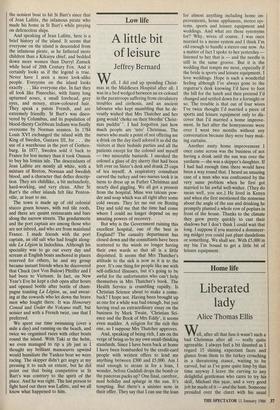High life
Paradise isle
Taki
St Barthelemy Imagine what the Caribbean was 25 years ago, before the 3,000-mile-long neck- lace of islands stretching from the Bahamas to South America became as popular as Cannes and Monte Carlo, and you'll have a pretty good idea what St Bart's is like. Picture empty beaches, a leisurely rhythm of life, cacti of various shapes, emerald- green or turquoise-coloured water, a lush and mountainous interior, and a few tour- ists with nothing much to do except swim, sunbathe, windsurf, snorkel, and drink rum punches, and you'll get the perfect picture of St Bart's. More important, you'll understand why it's the only island to visit during a time of year everyone — including the muggers of the South Bronx — seems to be holidaying down here.
St Barthelemy is a small island, inha- bited by 2,500 whites, and it lies south-east of St Maarten, in the part of the Caribbean known as the Lesser Antilles. It is French territory, without high-risers, no glass-and- concrete ranks, and without a conspicuous- ly Guccied and Cartiered crowd. In the one week I spent here I counted two stinkpots among the yachts that anchored around the island. Needless to say, one was American owned, the other British. Just as needless to mention is the fact that the owners of both those gigantic stinkpots turned out to be the types of fellow Armand Hammer, or perhaps George Weidenfeld, would feel at home with, which meant that along with the cooling breezes, the beautiful topless girls, and the excellent rum drinks, my group also had two figures of fun adding to our pleasurable stay.
Happily, there were countless sailing boats, including the one I was on, a 71-foot ketch called Miss Two, chartered by us from a friend of mine at a price that was hardly friendly but certainly reasonable. My friend Chuck (not Von Bulow) Pfeif- fer, two other rugged types, and a few girls, plus the excellent crew, made up what by the end of the week was known as the noisiest boat to hit St Bart's since that of Jean Lafitte, the infamous pirate who made his home in St Bart's while preying on defenceless ships.
And speaking of Jean Lafitte, here is a brief history of the island. It seems that everyone on the island is descended from the infamous pirate, as he fathered more children than a Kikuiyu chief, and bedded down more women than Darryl Zanuck while head of 20th Century Fox. And it certainly looks as if the legend is true. Never have I seen a more look-alike people. Everyone on the island looks exactly . . . like everyone else. In fact they all look like Pinnochio, with funny long upturned noses, a small forehead, grey eyes, and mousy, straw-coloured hair. They speak a patois French, and are extremely friendly. St Bart's was disco- vered by Columbus, and its population of blood-thirsty Caribbean Indians was finally overcome by Norman seamen. In 1784 Louis XVI exchanged the island with the King of Sweden, Gustave III, for . . . the use of a warehouse in the port of Gothen- burg. In 1877, Sweden sold it back to France for less money than it took Onassis to buy his Ionian isle. The descendants of Jean Lafitte are mostly all white, with a mixture of Breton, Norman and Swedish blood, and a character that defies descrip- tion. They are childlike, a bit melancholy, hard-working, and very clean. After St Bart's the other islands felt like Penton- ville, at least to me.
The town is made up of old colonial stucco green houses, with red tile roofs, and there are quaint restaurants and bars along the narrow streets. The gendarmerie and the port captain are among those who are not inbred, and who are from mainland France. I made friends with the port captain, an old salt who had fought along- side La Legion in Indochina. Although his speciality was to go out every day and scream at English boats anchored in places reserved for others, he and my group became instant friends when he discovered that Chuck (not Von Bulow) Pfeiffer and I had been to Vietnam. In fact, on New Year's Eve he kept a club open after hours and opened bottle after bottle of cham- pagne toasting La Legion, us, and swear- ing at the cowards who let down the brave men who fought there. It was Honorary Consul and Under the Volcano stuff, but noisier and with a French twist, one that I preferred.
We spent our time swimming (over a mile a day) and running on the beach, and twice we organised races with other boats round the island. With Taki at the helm, we even managed to rip a jib just as I thought my brilliant manoeuvre upwind would humiliate the Yankee boat we were racing. The skipper didn't get angry at my pressing it to such an extent, but he did point out that being competitive in St Bart's was contrary to the spirit of the place. And he was right. The last person to fight hard out there was Lafitte, and we all know what happened to him.



























































 Previous page
Previous page